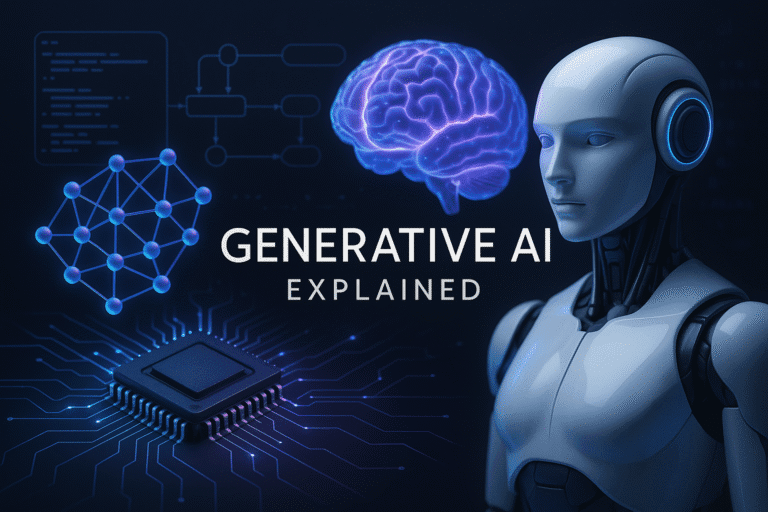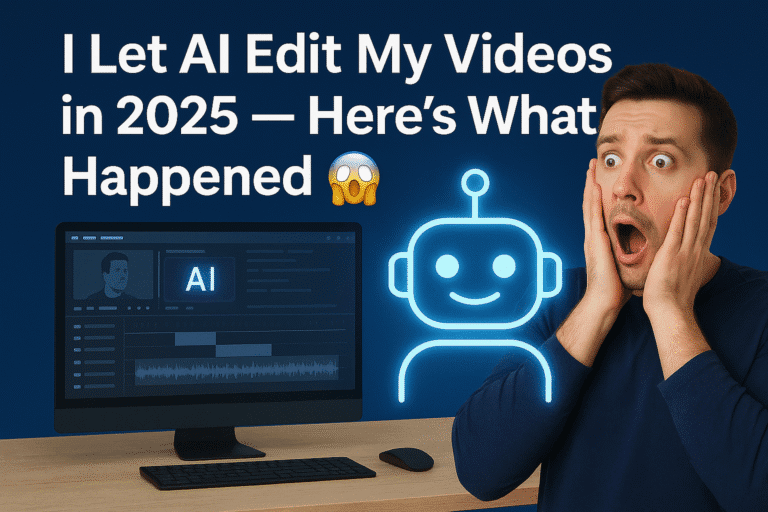Breaking Down the Language Barrier
In our increasingly connected world, the ability to communicate effectively across languages has become a non-negotiable for businesses looking to expand globally. Yet, the traditional approach to multilingual content creation has been a brutal cycle of:
- Create content in your primary language
- Send it to translators (and wait… and wait…)
- Receive translations that miss your brand voice
- Spend more time and money fixing the issues
- Finally publish—weeks after your original timeline
But 2025 has changed everything. Top AI-powered tools are transforming what was once a cumbersome, expensive process into something remarkably efficient and accessible for businesses of all sizes.
In this comprehensive guide, we’ll explore how AI is reshaping multilingual content creation, examine the best tools available right now, and help you navigate this exciting but complex landscape with confidence.
The Multilingual Content Landscape in 2025
The landscape of multilingual content creation has evolved dramatically in recent years. As businesses expand globally, the demand for efficient, accurate, and culturally appropriate content across multiple languages has skyrocketed.
Today’s market offers a diverse range of AI-powered solutions that go beyond simple translation. These advanced tools now provide capabilities in neural machine translation, tone preservation, and cultural adaptation that were unimaginable just a few years ago.
This guide offers a comprehensive analysis of the most innovative and effective tools reshaping global content strategy in 2025.
What is Multilingual Content Creation with AI?
At its core, multilingual content creation with AI refers to using artificial intelligence technologies to generate, translate, adapt, and optimize content for multiple language markets simultaneously. Unlike traditional translation, which simply converts text from one language to another, modern AI-powered multilingual content creation encompasses:
- Neural machine translation that understands context and nuance
- Content generation that can create original pieces in multiple languages
- Localization assistance that adapts content to cultural contexts
- Multilingual SEO optimization for better global search visibility
- Voice and video adaptation across languages
The most powerful systems combine several of these capabilities, allowing content teams to scale their global presence without scaling their headcount at the same rate.
Why AI is a Game-Changer for Global Content Teams in 2025
-
Speed and Efficiency
What once took weeks now takes hours or even minutes. AI tools can translate and localize content almost instantly, allowing teams to publish in multiple markets simultaneously rather than sequentially.
-
Cost Reduction
The economics are compelling: while professional human translation can cost $0.10-$0.30 per word, AI translation costs have plummeted to fractions of a penny per word for many language pairs. For a 2,000-word article translated into 10 languages, the difference can be thousands of dollars.
-
Scalability Without Compromise
Adding a new language market no longer requires hiring new translators or editors. With AI tools, expanding to a new language can be as simple as selecting it from a dropdown menu.
-
Consistency Across Languages
AI ensures that your messaging, terminology, and brand voice remain consistent regardless of language—something that’s challenging to maintain with multiple human translators.
-
Real-time Updates
When your primary content changes, AI can instantly update all language versions, eliminating version control nightmares.
Top 10 Best AI Tools for Multilingual Content Creation in 2025
1. DeepL
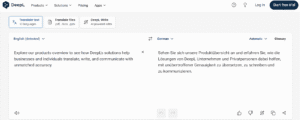
Features:
- Highly nuanced neural machine translation
- API for seamless workflow integration
- Document translation with formatting preservation
- Glossary feature for consistent terminology
Languages Supported: 30+ languages with exceptional quality for European languages
Pros:
- Industry-leading translation quality, often indistinguishable from human translation
- Excellent at preserving tone and context
- User-friendly interface with fast processing
Cons:
- Fewer languages than some competitors
- Higher pricing for enterprise volumes
Ideal Use Case: High-value content where quality and nuance matter, such as marketing materials and product descriptions
Price Range: Free tier available; Pro plans from $8.99/month; Enterprise pricing based on volume
2. Google Translate

Features:
- Text, voice, and image translation
- Real-time conversation translation
- Offline capabilities
- Integration with Google Workspace
Languages Supported: 133 languages
Pros:
- Widest language coverage in the industry
- Free for basic use
- Continually improving neural translation models
- Robust mobile app
Cons:
- Quality varies significantly by language pair
- Limited customization options
- Less nuanced than specialized tools
Ideal Use Case: Quick translations, understanding foreign content, basic communication needs
Price Range: Free for basic use; API pricing starts at $20 per million characters
3. Synthesia
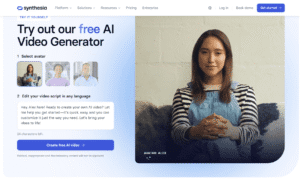
Features:
- AI video creation with multilingual avatars
- Text-to-speech in 65+ languages
- Customizable AI presenters
- Video templates for different use cases
Languages Supported: 65+ languages for voice synthesis
Pros:
- Creates professional-looking videos without filming
- Excellent for training and educational content
- Significant time and cost savings compared to traditional video localization
Cons:
- Limited emotional range in AI presenters
- Some languages have fewer voice options
- Higher learning curve than text-only tools
Ideal Use Case: Training videos, product demonstrations, and promotional content that needs to be localized for multiple markets
Price Range: Starting at $30/month; enterprise plans available
4. Murf AI

Features:
- Natural-sounding voiceovers from text
- Voice cloning capabilities
- Customizable speech styles
- Studio features for audio editing
Languages Supported: 130+ languages and accents
Pros:
- Highly natural voice synthesis
- Excellent prosody and intonation
- Voice style and emotion controls
- Time-efficient alternative to voice actors
Cons:
- Some languages have fewer voice options
- Higher-quality voices come at premium pricing
- Limited advanced audio editing features
Ideal Use Case: Podcasts, explainer videos, e-learning content, and audiobooks in multiple languages
Price Range: Free plan available; paid plans from $19/month
5. Rask.ai
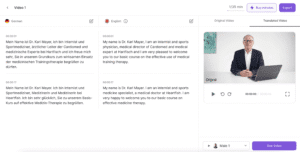
Features:
- AI video translation with lip-syncing
- Voice cloning across languages
- Automatic subtitle generation
- Video content localization workflow
Languages Supported: 130+ languages
Pros:
- Revolutionary lip-sync technology for realistic dubbing
- Preserves speaker identity across languages
- Automated workflow reduces localization time by 90%
- Supports various video formats
Cons:
- Premium pricing
- Complex projects may require human review
- Processing time for longer videos
Ideal Use Case: Marketing videos, corporate communications, and entertainment content requiring professional-looking localization
Price Range: Starting at $29/month; custom enterprise pricing
6. Lokalise AI
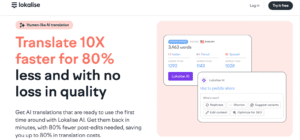
Features:
- AI-powered translation management system
- QA checks for translation quality
- Collaboration tools for teams
- Continuous localization workflows
Languages Supported: 30+ languages with high-quality neural MT
Pros:
- End-to-end solution for content localization
- Developer-friendly with robust API
- Combines AI translation with human review options
- Version control and content organization
Cons:
- More complex than pure translation tools
- Primarily designed for software and website localization
- Higher price point than standalone tools
Ideal Use Case: Software companies, websites, and apps requiring continuous localization across multiple languages
Price Range: Starting at $90/month; enterprise pricing available
7. Copy.ai
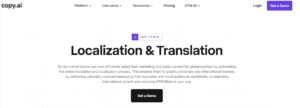
Features:
- AI-powered content generation
- Multilingual content creation
- Marketing-focused templates
- Tone and brand voice controls
Languages Supported: 25+ languages for content generation
Pros:
- Creates original content rather than just translating
- Marketing-specific focus with conversion optimization
- User-friendly interface with minimal learning curve
- Consistent brand voice across languages
Cons:
- Quality varies by language
- Best for shorter-form content
- May require editing for industry-specific content
Ideal Use Case: Social media posts, ad copy, product descriptions, and email marketing across multiple languages
Price Range: Free plan available; paid plans from $36/month
8. Jasper AI
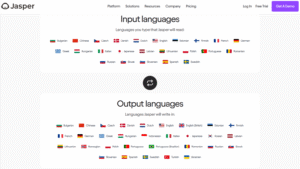
Features:
- AI writing assistant with multilingual capabilities
- Content templates for various formats
- Brand voice customization
- Integration with Grammarly and other tools
Languages Supported: 30+ languages
Pros:
- Versatile content creation across multiple formats
- Strong long-form content capabilities
- SEO integration for optimized content
- Team collaboration features
Cons:
- Higher price point than some competitors
- Better for creating new content than translating existing content
- Output quality varies by language
Ideal Use Case: Blog posts, articles, and long-form marketing content for multinational campaigns
Price Range: Starting at $39/month; business plans from $99/month
9. Wordly.ai

Features:
- Real-time speech translation
- Multilingual transcription
- Virtual event translation
- Audience language selection
Languages Supported: 20+ languages for simultaneous interpretation
Pros:
- Revolutionizes multilingual events and conferences
- No interpretation booths or equipment needed
- Attendees can select their preferred language
- Provides transcripts in all languages
Cons:
- Primarily focused on live events
- Requires good audio quality
- Less effective for highly technical or specialized content
Ideal Use Case: Webinars, conferences, training sessions, and meetings with international participants
Price Range: Custom pricing based on event size and languages
10. Vozo AI

Features:
- AI video translation and dubbing
- Voice cloning technology
- Precise lip-syncing
- Subtitle generation and editing
Languages Supported: 61+ source languages, 29 target languages
Pros:
- High-quality dubbing that matches lip movements
- Preserves speaker’s voice characteristics
- Faster and more cost-effective than traditional dubbing
- Integrated workflow from translation to final video
Cons:
- Processing time for longer videos
- Premium pricing
- Some rare languages have limited voice options
Ideal Use Case: Professional video content requiring high-quality localization, such as corporate training, marketing videos, and entertainment
Price Range: Starting at $49/month; custom enterprise plans
AI for Localization vs. Translation: What’s the Difference?
Imagine you’re launching a summer promotion for your cold brew coffee in both the US and Australia. A simple translation would keep the same messaging, just in different languages. But localization? That’s where AI now shines.
A properly localized campaign would recognize that it’s winter in Australia during the US summer and adapt accordingly—perhaps positioning the product as a “refreshing year-round treat” rather than a “summer cooldown.”
Modern AI localization tools can:
- Adapt cultural references and idioms
- Modify imagery and color schemes based on cultural preferences
- Adjust product messaging to align with local values
- Transform measurements, dates, and currencies automatically
- Recommend alternate approaches for concepts that don’t translate well
Take the example of a financial services company that tried to promote their “piggy bank” savings feature globally. A good AI localization tool would flag that in some cultures, pigs aren’t associated with savings, and suggest culturally appropriate alternatives.
The best AI tools in 2025 don’t just translate your words—they translate your intentions and adapt your message to resonate with each target audience.
AI vs. Human Translation: What You Should Know in 2025
The landscape has shifted dramatically in recent years, but there are still important distinctions to understand:
Where AI Excels:
- Volume and speed: AI can translate millions of words daily
- Consistency: The same term is always translated the same way
- Technical content: Well-defined terminology is handled accurately
- Cost efficiency: Fraction of the cost of human translation
- Integration: Seamless incorporation into content workflows
Where Humans Still Have the Edge:
- Creative adaptation: Slogans, puns, and wordplay
- Cultural nuance: Deeply understanding cultural context
- Brand voice: Capturing subtle aspects of brand personality
- Specialized fields: Highly regulated industries like legal and medical
- Strategic decisions: Determining what should be adapted vs. directly translated
The most effective approach in 2025 is a hybrid model: AI handles the heavy lifting of initial translation and standard content, while human experts focus on review, creative elements, and strategic adaptation. This combination delivers the best of both worlds—speed and scale from AI, creativity and nuance from humans.
Using AI for Multilingual SEO and Global Content Strategy
Creating content in multiple languages is only valuable if your audience can find it. This is where multilingual SEO comes in, and AI tools are transforming this process in several ways:
1. Keyword Research Across Languages
Modern AI tools don’t just translate your English keywords—they identify the actual search terms people use in each market. For example, while Americans search for “cell phone plans,” Brits look for “mobile tariffs,” and Germans search for “Handyvertrag.” AI tools like Jasper AI now identify these differences automatically.
2. Intent Analysis by Market
Search intent can vary significantly across cultures. AI can analyze search patterns in each market to determine whether users searching for a term are typically looking for information, comparisons, or ready to purchase.
3. Multilingual Schema Markup
AI tools can generate appropriate schema markup for each language version of your content, improving how search engines understand and display your content in different markets.
4. Content Gap Analysis
The most advanced AI systems can identify topics that perform well in one language but are missing in others, helping you prioritize your content creation efforts.
Examples in Practice:
A global e-commerce retailer used AI to analyze search patterns across 12 markets and discovered that:
- Their German customers were 3x more likely to search for sustainability information than US customers
- Brazilian customers frequently searched for installment payment options—content they hadn’t prioritized
- Japanese customers searched for detailed product specifications that were buried deep in their site
By adapting their content strategy to these insights, they saw organic traffic increase by 45% across their non-English markets.
Free vs. Paid AI Tools for Multilingual Content: Which One to Choose?
Free Tools: Best For
- Individual creators and solopreneurs
- Small projects with basic translation needs
- Occasional use rather than ongoing campaigns
- Testing the waters before investing in premium tools
Paid Tools: Worth It When
- Quality and accuracy are non-negotiable
- Brand consistency across languages is crucial
- Volume of content justifies the investment
- Specialized content requires industry-specific knowledge
- Workflow integration would save significant time
Decision Framework
Consider these factors when deciding between free and paid options:
- Volume: How many words/minutes of content do you need to create monthly?
- Languages: Are you targeting major languages (where free tools shine) or more specialized markets?
- Content type: Is it straightforward informational content or nuanced marketing material?
- Technical requirements: Do you need API access, CMS integration, or specialized workflows?
- Budget reality: What’s the cost of poor translation versus the investment in better tools?
For small businesses dipping their toes into new markets, starting with free tools like Google Translate makes sense. As your international presence grows, graduating to specialized tools like DeepL or Lokalise provides the quality and features needed for serious global operations.
The Future of AI-Powered Global Content Creation
As we look toward the horizon, several emerging trends will shape multilingual content creation in the coming years:
-
Real-time Cross-language Collaboration
Teams will collaborate in their native languages, with AI providing seamless translation in real-time. Imagine a French copywriter, German designer, and Japanese marketer all working on the same campaign, each seeing content in their preferred language.
-
Multimodal Content Adaptation
Future AI will simultaneously adapt text, images, audio, and video to create culturally relevant experiences, automatically adjusting visual metaphors and references to resonate with each market.
-
Hyper-personalization Across Languages
AI will not only translate content for different languages but also adapt it for different audience segments within each language market, considering regional dialects, industry terminology, and even company-specific language.
-
Emotion and Tone Preservation
The next frontier is perfectly capturing emotional resonance across languages. Advanced systems will ensure that content that’s humorous, inspirational, or authoritative in the source language creates exactly the same emotional response in the target language.
-
Predictive Localization
Rather than waiting for content to be created and then localized, AI will suggest global-friendly approaches during the initial creation process, flagging potential localization issues before they arise.
The organizations that embrace these technologies now will establish a powerful competitive advantage as global markets become increasingly connected yet culturally distinct.
Embracing the Multilingual AI Revolution
The ability to communicate effectively across languages is no longer a luxury—it’s a competitive necessity. The tools highlighted in this guide represent the cutting edge of what’s possible in 2025, enabling businesses of all sizes to create authentic connections with global audiences.
As you evaluate these solutions, remember that the goal isn’t just translation, but true communication that resonates across cultural and linguistic boundaries. The most successful global brands don’t just speak different languages; they speak to different cultures with authentic, adapted messaging.
Whether you’re a solopreneur looking to expand your reach or an enterprise managing complex global campaigns, there’s never been a better time to leverage AI for multilingual content creation. The question is no longer whether you can afford to go global, but whether you can afford not to.
Ready to transform your global content strategy? Start by experimenting with one of the free tools mentioned above, or dive deeper with a free trial of a premium solution like DeepL or Jasper AI. Your global audience is waiting.
Looking for more insights on cutting-edge AI tools? Explore our related guides:
- Top AI Video Editors Comparison
- ChatGPT Latest Models Comparison
- ChatGPT vs Meta AI vs Gemini Comparison
- ChatGPT Alternatives: Best AI Tools
- Top AI Tools for Writing and Rewriting
- Top AI Productivity Tools
- DeepSeek vs ChatGPT
- Best AI Image Generators

